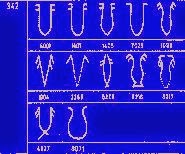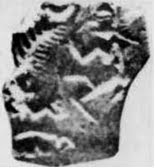Mirror: https://www.academia.edu/7761493/Meluhha_epigraphs_including_hieroglyph_190_sprouts_in_watery_field_of_Mahadevan_Sign_List
http://www.scribd.com/doc/234989354/Meluhha-epigraphs-including-hieroglyph-190-sprouts-in-watery-field-of-Mahadevan-Sign-List
The following readings suggested are consistent with the cipher presented in “Meluhha hieroglyphs on cylinder and other seals of Bronze Age”
https://www.academia.edu/6898842/Meluhha_hieroglyphs_on_cylinder_and_other_seals_of_Bronze_Age
http://www.scribd.com/doc/234989354/Meluhha-epigraphs-including-hieroglyph-190-sprouts-in-watery-field-of-Mahadevan-Sign-List
Meluhha epigraphs including hieroglyph 190 (‘sprouts in watery field’) of Mahadevan ‘Sign List’
S. Kalyanaraman July 23, 2014
Wim Borsboom and SM Sullivan discuss this hieroglyph in the context of Sanskrit readings of a few Indus script epigraphs. http://www.academia.edu/7751469/Decipherment_Interpretation_and_Translation_of_Indus_Script_Sign_430_Sinha_ The readings do not refer to the pictorial motif hieroglyphs (such as one-horned young bull, rhinoceros, tiger) which occupy the field on some epigraphs.
I would suggest variant readings – of both ‘sign’ glyphs and ‘pictorial motif’ glyphs. They are treated as hieroglyph rebus cipher based on Meluhha which was the lingua franca of artisans and traders of the civilization region. The inscriptions recorded trade transactions along the Tin Road of Bronze Age. – as descriptive parts or bills of materials in bills of lading. http://www.academia.edu/7751469/Decipherment_Interpretation_and_Translation_of_Indus_Script_Sign_430_Sinha_
The following readings suggested are consistent with the cipher presented in “Meluhha hieroglyphs on cylinder and other seals of Bronze Age”
https://www.academia.edu/6898842/Meluhha_hieroglyphs_on_cylinder_and_other_seals_of_Bronze_Age
Top left: Shortugai, Bactria (Jarrige 1984). Top right: H-48A
Middle: 1. M-543A. 2, 3. M2047 AB. 4. M-1498A
Bottom: 1. M-546A 2. M-1498B
In these examples of epigraphs, six pictorial motifs are vivid and clearly distinguishable as occupying the field:
1. Standard device (in front of the one-horned young bull with a pannier)
2. Trough
3. One-horned young bull with a pannier (and rings on neck)
4. Ox
5. Tiger
6. Rhinoceros
Some examples of ‘signs’ as hieroglyphs are:
||| Number three
Part A. Pictorial motif hieroglyphs
pattar ‘trough’ rebus: pattar ‘guild’.
sangada 'lathe', 'portable furnace'G. sãghāṛɔ m. ʻlathe’ ;sã̄gāḍā m. ʻ frame of a building ʼ, °ḍī f. ʻ lathe ʼ(CDIAL 12859)Rebus:
sangataras. संगतराश lit. ‘to collect stones, stone-cutter, mason.’ संगतराश संज्ञा पुं० [फ़ा०] पत्थर काटने या गढ़नेवाला मजदूर । पत्थरकट । २. एक औजार जो पत्थर काटने के काम में आता है । (Dasa, Syamasundara. Hindi sabdasagara. Navina samskarana. 2nd ed. Kasi : Nagari Pracarini Sabha, 1965-1975.) पत्थर या लकडी पर नकाशी करनेवाला, संगतराश, ‘mason’.
Ku. balad m. ʻ ox ʼ, gng. bald, N. (Tarai) barad, id. Rebus: L. bhāraṇ ʻ to spread or bring out from a kiln ʼ; M. bhārṇẽ, bhāḷṇẽ ʻ to make strong by charms (weapons, rice, water), enchant, fascinate (CDIAL 9463) Ash. barī ʻ blacksmith, artisan (CDIAL 9464). Baran, bharat ‘mixed alloys’ (5 copper, 4 zinc and 1 tin) (Punjabi) bharana id. (Bengali) bharan or toul was created by adding some brass or zinc into pure bronze. bharata = casting metals in moulds (Bengali)
खोंडी [ khōṇḍī ] f An outspread shovelform sack (as formed temporarily out of a कांबळा, to hold or fend off grain, chaff &c.) (Marathi) koḍiyum'rings on neck' (Gujarati)
kondh ‘heifer’. kōḍu horn (Kannada. Tulu. Tamil) खोंड [khōṇḍa] m A young bull, a bullcalf. (Marathi) Rebus: kõdār 'turner' (Bengali); kõdā ‘to turn in a lathe’ (Bengali).कोंद kōnda ‘engraver, lapidary setting or infixing gems’ (Marathi) kõdā ‘lathe-turner’. kũdār ‘turner, brass worker’. कोंद kōnda ‘engraver, lapidary setting or infixing gems’ (Marathi) kũdār, kũdāri (B.); kundāru (Or.)कोंडण [kōṇḍaṇa] f A fold or pen. (Marathi) खोट [khōṭa] Alloyed--a metal (Marathi).
kul 'tiger' (Santali); kōlu id. (Te.) kōlupuli = Bengal tiger (Te.)Pk. kolhuya -- , kulha -- m. ʻ jackal ʼ < *kōḍhu -- ; H.kolhā, °lā m. ʻ jackal ʼ, adj. ʻ crafty ʼ; G. kohlũ, °lũ n. ʻ jackal ʼ, M. kolhā, °lā m. krōṣṭŕ̊ ʻ crying ʼ BhP., m. ʻ jackal ʼ RV. = krṓṣṭu -- m. Pāṇ. [√kruś] Pa. koṭṭhu -- , °uka -- and kotthu -- , °uka -- m. ʻ jackal ʼ, Pk. koṭṭhu -- m.; Si. koṭa ʻ jackal ʼ, koṭiya ʻ leopard ʼ GS 42 (CDIAL 3615). कोल्हा [ kōlhā ] कोल्हें [ kōlhēṃ ] A jackal (Marathi) kol ‘tiger, jackal’ (Konkani.) Rebus: kol ‘iron’ (Tamil.) Rebus: kol ‘furnace, forge’ (Kuwi) kol ‘alloy of five metals, pañcaloha’ (Tamil.)
gaṇḍá4 m. ʻ rhinoceros ʼ lex., °aka -- m. lex. 2. *ga- yaṇḍa -- . [Prob. of same non -- Aryan origin as khaḍgá --1: cf. gaṇōtsāha -- m. lex. as a Sanskritized form ← Mu. PMWS 138]1. Pa. gaṇḍaka -- m., Pk. gaṁḍaya -- m., A. gãr, Or. gaṇḍā. 2. K. gö̃ḍ m., S. geṇḍo m. (lw. with g -- ), P. gaĩḍā m., °ḍī f., N. gaĩṛo, H. gaĩṛā m., G. gẽḍɔ m., °ḍī f., M. gẽḍā m.Addenda: gaṇḍa -- 4. 2. *gayaṇḍa -- : WPah.kṭg. geṇḍɔ mirg m. ʻ rhinoceros ʼ, Md. genḍā ← H. (CDIAL 4000). காண்டாமிருகம் kāṇṭā-mirukam , n. [M. kāṇṭāmṛgam.] Rebus: kāṇḍa ‘tools, pots and pans and metal-ware’ (Gujarati) Rebus: khāṇḍa ‘tools, pots and pans and metal-ware’ (Marathi)
Part B. ‘Signs’ as hieroglyphs
er-aka 'upraised arm' (Ta.); rebus: eraka = copper (Ka.)
adaru 'twig'; rebus: aduru 'native, unsmelted metal'.
kolmo ‘three’; rebus: kolom'sprout'; kolom = cutting, graft; to graft, engraft, prune; kolma hoṛo = a variety of the paddy plant (Desi)(Santali.) kolmo 'rice plant' (Mu.) rebus: kolami ‘forge, smithy’ (Telugu)
kolmo ‘rice plant’ (Mu.) Rebus: kolami ‘furnace,smithy’ (Te.) Vikalpa: pajhaṛ = to sprout from a root (Santali); Rebus: pasra ‘smithy, forge’ (Santali)
kūdī ‘bunch of twigs’ (Sanskrit) rebus: kuṭhi‘smelter furnace’ (Santali)
Hieroglyph: 'rim-of-jar': Phonetic forms: kan-ka (Santali) karṇika (Sanskrit) Rebus: karṇī, supercargo for a boat shipment. karṇīka ‘account (scribe)’.कारणी kāraṇī ‘the supercargo of a ship’ (Marathi) कर्णधार [ karṇadhāra ] m S (A holder of the ear.) A helmsman or steersman देशकुळकरणी [dēśakuḷakaraṇī] m An hereditary officer of a Mahál. He frames the general account from the accounts of the several Khots and Kulkarn̤ís of the villages within the Mahál; the district-accountant.
mēd ‘body’ (Kur.)(DEDR 5099); rebus: mered (Mundari); meḍ'iron' (Ho)
Left: a seal published by Omananda Saraswati. In Pl. 275: Omananda Saraswati 1975. Ancient Seals of Haryana (in Hindi). Rohtak.” (I. Mahadevan, 'Murukan' in the Indus Script, The Journal of the Institute of Asian Studies, March 1999). B.B. Lal, 1960. From Megalithic to the Harappa: Tracing back the graffiti on pottery. Ancient India, No.16, pp. 4-24.
bharaDo ‘spine’ (Gujarati); spine, backbone (Punjabi); baraDo thADavo lit. to strike on the backbone or back (Gujarati). baraDo -barad BHANGI NAKHI- Brocken) - means KED/KAMAR Backbone specifically of LUMBAR REGION (Kutchi. Gujarati). Rebus: L. bhāraṇ ʻ to spread or bring out from a kiln ʼ; M. bhārṇẽ, bhāḷṇẽ ʻ to make strong by charms (weapons, rice, water), enchant, fascinate (CDIAL 9463) Ash. barī ʻ blacksmith, artisan (CDIAL 9464). Baran, bharat‘mixed alloys’ (5 copper, 4 zinc and 1 tin) (Punjabi) bharana id. (Bengali) bharan or toul was created by adding some brass or zinc into pure bronze. bharata = casting metals in moulds (Bengali)
Alternative 1: Pa. piṭṭhi -- kaṇṭaka -- m. ʻ bone of the spine ʼ; Tir. mar -- kaṇḍḗ ʻ back (of the body) ʼ; S. kaṇḍo m. ʻ back ʼ, L. kaṇḍ f., kaṇḍā m. ʻ backbone ʼ, awāṇ. kaṇḍ, °ḍī ʻ back ʼ; N. kaṇḍo ʻ buttock, rump, anus ʼ, kaṇḍeulo ʻ small of the back ʼ; H. kã̄ṭā m. ʻ spine ʼ, G. kã̄ṭɔ m., M. kã̄ṭā m.; Si. äṭa -- kaṭuva ʻ bone ʼ, piṭa -- k° ʻ backbone ʼ. Pk. kaṁḍa -- m. ʻ backbone ʼ. Pk. karaṁḍa -- m.n. ʻ bone shaped like a bamboo ʼ, karaṁḍuya -- n. ʻ backbone ʼ. Rebus: khāṇḍā ‘metal tools, pots and pans’ (Marathi) Rebus: kāṇḍa ‘tools, pots and pans and metal-ware’ (Gujarati)
Alternative 2 kaseru [Skt.] n. The backbone. rebus: kasērā ʻ metal worker ʼ, (Lahnda) P. kaserā m. ʻ worker in pewter ʼ (CDIAL 2988, 2989)





